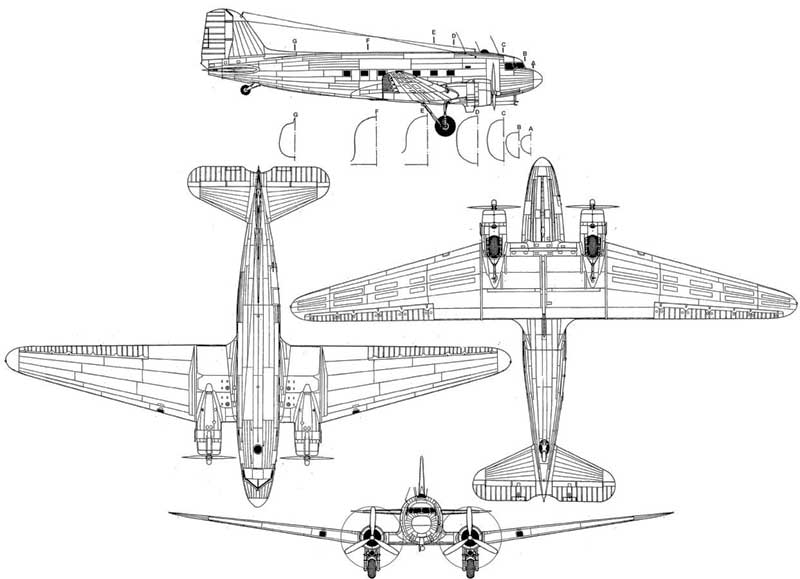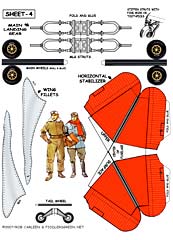
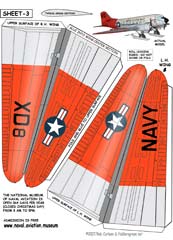
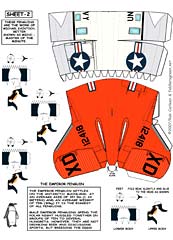
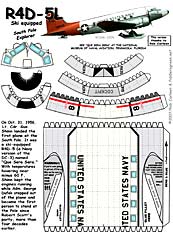
Skytrain C-47 / DC-3 - $$7.95
This C-47 actually hauled a Waco CG-4 Invasion Glider into the thick of it at Normandy. The glider and tiny model Jeep model is available in matching scale. Redrawn March 07 with the help of Rob Carleen who also created the RD4-5L Navy version that landed at the South Pole in October 1956.
Douglas C-47 SkyTrain (Gooney Bird) DC-3
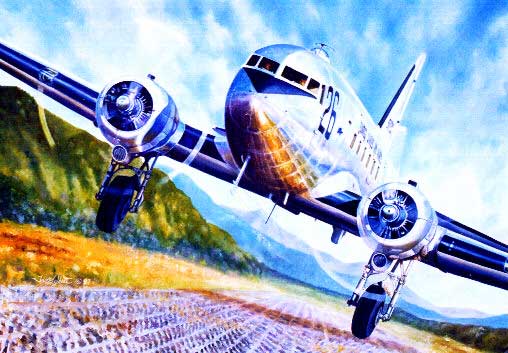
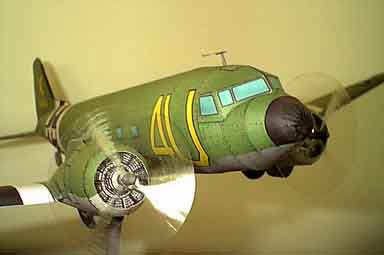 Few aircraft were as well known or were so widely used for so long
as the C-47 or 'Gooney Bird" as it was affectionately nicknamed.
The C-47 was adapted from the DC-3 commercial airliner which appeared
in 1936. By the end of WWII. 9,348 had been procured for AAF use.
Few aircraft were as well known or were so widely used for so long
as the C-47 or 'Gooney Bird" as it was affectionately nicknamed.
The C-47 was adapted from the DC-3 commercial airliner which appeared
in 1936. By the end of WWII. 9,348 had been procured for AAF use.
They carried personal and cargo and in a combat role, towed troop
carrying gliders and dropped paratroops into enemy territory. This
C-47 is on exhibit at the Evergreen Air Museum at McMinnville, Oregon
- the new home of the Spruce Goose.
This C-47 actually hauled a Waco CG-4 Invasion Glider into the thick
of it at Normandy. The glider and tiny model Jeep model is available
in matching scale.
Thanks again for all the freebies you have sent me. My art students have been using your models all year long. One of my autistic (not artistic) students keeps asking for my more models to do and I keep printing up more for him to do on the weekends and Easter break. He'll be happy to see this C-47. God bless, Mike Bennett, Canyon Middle School, Yucaipa, CA
Awesome !! Truly awesome AND its a cool addition to the collection.. Modee
I have built a Flying Model of your DC-3. it`s built from Durobatics, which is very thin polystyrene foam sheets (0.05in and 0.025in). Wingspan 63cm, weight 32g, powered by Kyosho / Parkzone Minimum Cessna RX/Regulator and motors flies with the standard 1 Zell 70mAh Akku 4-5 minutes.
There is a build thread there: http://www.rcgroups.com/forums/showthread.php?t=861573
your planes are great !! i will definitely do another one :)Best Regards
Phillip Artweger
This is the Skytrain C-47 model that won the FG Modeling Madness (FGMM) 2010 best in class prize. Thanks to John Jogerst who donated his $20 prize money to The Model'n Pals Fund and Hospitalized Vets Program! |
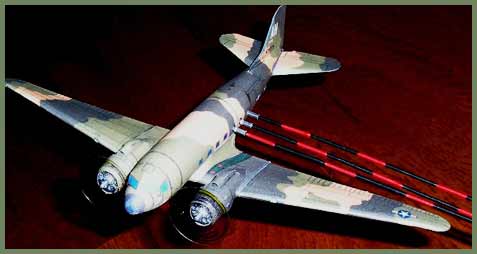 |
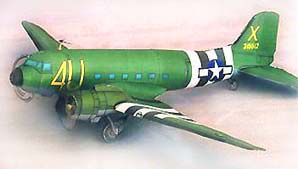

 Rob Carleen has added this RD4-SL Polar Explorer version and added it to the folder (see photos below) The model has, basically, been updated and re-drawn |
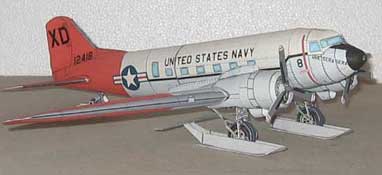 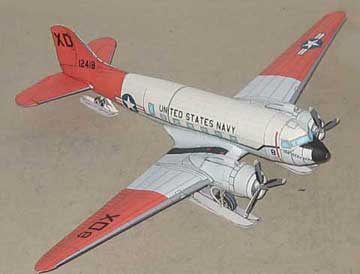 |
 |
 |
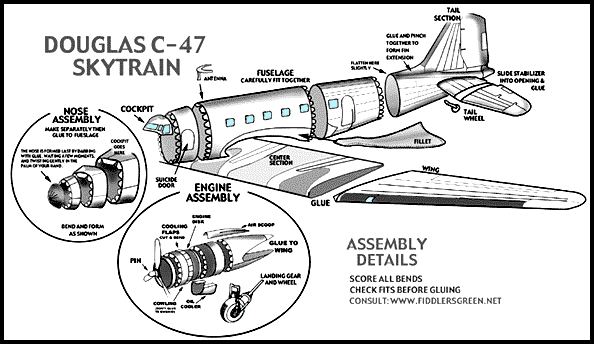
The development of the Douglas DC-3 was brought about by the commercial airlines demand for an economical passenger-carrying airplane. Up to 1934, airline passenger craft were too slow and carried too few passengers to be really profitable. United Air Lines had ordered sixty of the new Boeing 247s, the first truly modern airliners and had effectively tied up production. The 247 carried ten passengers at 160 mph and made all other transports obsolete, The other carriers were thus forced to find another plane if they wished to be competitive in the passenger-carrying business.

In 1933 the Douglas Aircraft Company designed a new passenger plane, as ordered by Transcontinental and Western airlines, to compete with the Boeing 247. The first model, the DC-1, was soon succeeded by the DC-2 and the start of quantity production. American Airlines, at the time, was using the slow Curtis Condor, which was Fitted with sleeper berths. American needed a new airplane able to compete with the DC-2 and the Boeing 247, but one with sleeping accommodations.
In 1935 C. H. Smith. president of American Airlines, made a direct request of Douglas to build a larger, more comfortable plane which could lure the luxury trade." On December 17, 1935. the Douglas Sleeper Transport (DST) made its first flight.
The original plane was designed as a luxury sleeper with seven upper and seven lower berths and a private forward cabin, The day plane version, known as the DC-3, had twenty-one seats instead of fourteen berths. The design included cantilever wings, all-metal construction, two cowled radial engines, retractable landing gear, and trailing edge flaps. The controls included an automatic pilot and two sets of instruments. The original design was so satisfactory that the basic specifications were never changed.
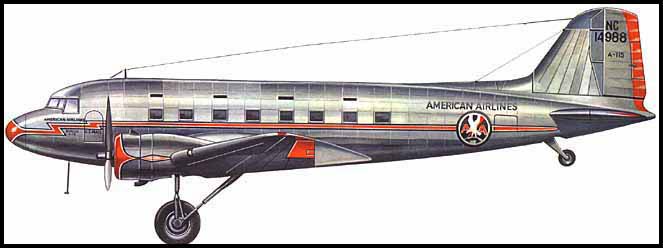 |
 |
American Airlines initiated DST nonstop New York-to-Chicago service on June 25, 1936, and in September started service with the 00-3. A year later, with the 00-3 in service, Smith stated, It was the first airplane in the world that could make money just by hauling passengers' This was the beginning of an immortal airplane known the world over. As the success of the DC-3, with its larger capacity for passengers, its speed, and its economical operation, was realized, airlines throughout the world began placing orders with Douglas.
In the United States the big three transcontinental lines were very competitive. With the advent of OST coast-to-boast service by American Airlines, Trans World Airlines obtained OST's and DC-3s for such flights also. When United Airlines, with its Boeing 247s, saw that the Douglas plane was outclassing its own serviced the company purchased ten OST's and five DC-3s, and began flights on January 1, 1937. In July of that same year United introduced sleeper service between New York and California.
By 1938, 95 percent of all U.S. commercial airline traffic was on DC-3s. Two hundred sixty DC3s, 80 percent of the number of airliners, were in service in 1942 on domestic carriers. As of December 31, 1969, thirty DC-3s were still being used by U.S. airlines.
Foreign companies also began to order the economical Douglas-built plane. KLM was the first European airline to own and operate DC-3s, in 1936, followed by companies in Sweden, Switzerland, France, Belgium, and elsewhere. By .1938 DC-3s were flown by thirty foreign airlines, and by 1939, 90 percent of the world's airline traffic was being carried by these aircraft.
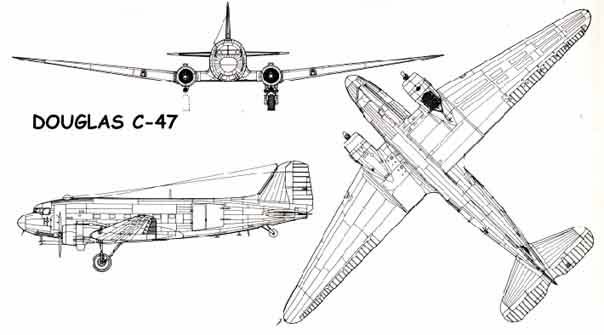
The impact of the 00-3 was felt the world over. In July 1936 President Franklin 0. Roosevelt presented Donald W. Douglas, head of Douglas Aircraft, with the Collier Trophy. Recognizing the DC-3 as the "outstanding twin-engine commercial plane," the citation read, This airplane, by reason of its high speed, economy, and quiet passenger comfort, has been generally adopted by transport tines throughout the United States, Its merit has been further recognized by its adoption abroad, and its influence on foreign design is already apparent.
In 1939 the 00-3 was called on to aid the military fleets of the world, Many commercial carriers in Europe put their DC-3s to use as military transports. The United States ordered new versions of the 00-3 modified for troop transport and cargo carrying. These were designated as C-47s and C53s. As military versions were built, they were put into operation in European and Pacific theaters during World War II. C-47s initiated the Berlin Airlift in 1948. In military service since 1941,the C-47 proved most useful in many endeavors.
Many names and numbers were assigned -to the DC-3. England labeled it the "Dakota" or 'Dak." American pilots, during World War II, called it the 'Skytrain," 'Skytrooper, "Doug," or Gooney Bird." The U.S. military's official titles were C-47, C53. 0-117, and R4D. The airlines called it 'The Three." Of all the names the affectionate title "Gooney Bird" lingers on.
The normal gross weight for the aircraft was 25,200 pounds, With twenty-one passengers. Many times these weights were exceeded as conditions required. The normal range was 1500 miles, but this could be extended by adding fuel tanks. The cruising speed varied from 155 mph to 190 mph depending on the load carried and the power used. The DC-3's' safety record was better than- that of most airplanes, primarily because of its great structural strength and efficient single-engine performance.
C-47
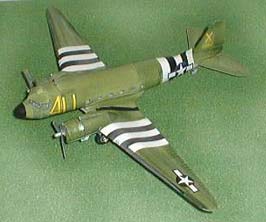 |
Wayne has quite a few models on our site and we really appreciate his efforts and enthusiasm! |

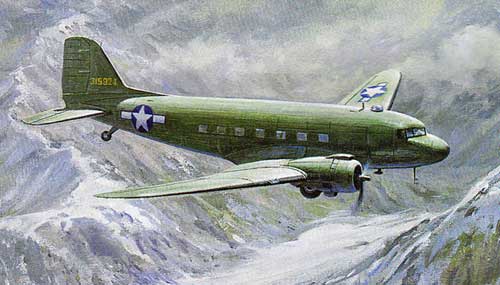
Of all the Allied wartime planes in use with the airborne forces, the C-47 Dakota was probably the best-known and the most widely used. It served both for parachute drops and as a glider tug in the Mediterranean sphere and in the Allied invasion of Europe in 1944. Together, the C-47 Dakota and the Waco glider proved a reliable and successful team which, despite occasional disaster, through unforeseen conditions, greatly contributed to Allied victory
Known as the Dakota by the British. the C-47 was manufactured by the Douglas Aircraft Company Inc. of Santa Monica, California and was a military adaptation of the DC-3 airliner. The C-47 was, essentially, a freight carrier and displayed a reinforced metal floor, a large door (for loading) and reinforced landing gear. The twin-engine Dakota was a low wing cantilever monoplane. In the supply role, it carried up to 6000 lb of equipment. As a paratroop aircraft, it was equipped with folding benches for 28 fully-armed troops.
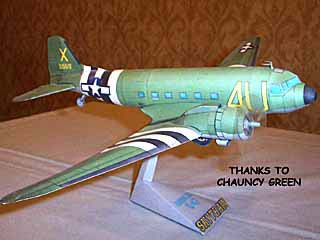 |
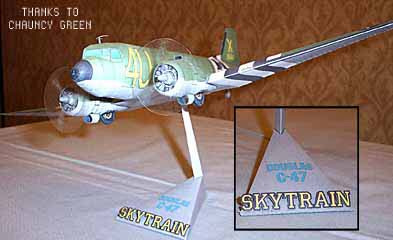 |
C-47
Of all the Allied wartime planes in use with the airborne forces,
the C-47 Dakota was probably the best-known and the most widely
used. It served both for parachute drops and as a slider tug in
the Mediterranean sphere and in the Allied invasion of Europe
in 1944. A.a tug, one of Its most common responsibilities was
the Waco glider seen on the.. pages, which, with the Ho... and
Harnilca, gliders, was the staple gliding transport of the Allied
airborne forces. Together, the C-47 Dakota and the Waco glider
proved a reliable and successful team which, despite occasional
disaster, through unforeseen conditions, greatly contributed to
Allied victory.
Specifications
Crew: 3
|
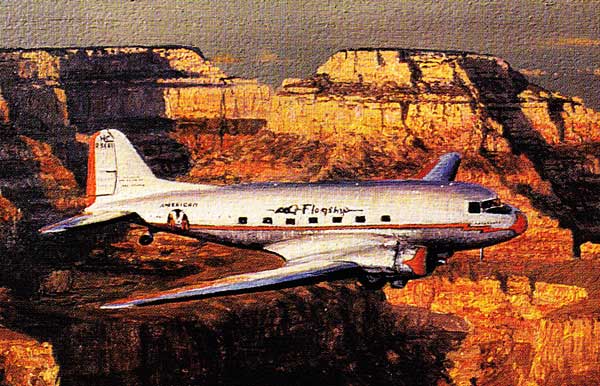
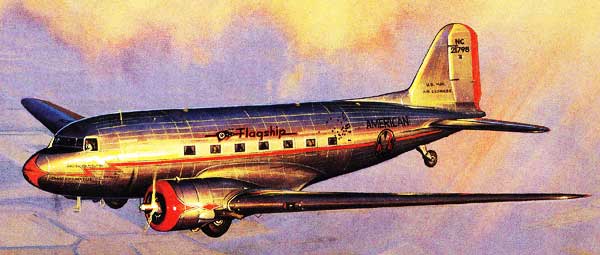
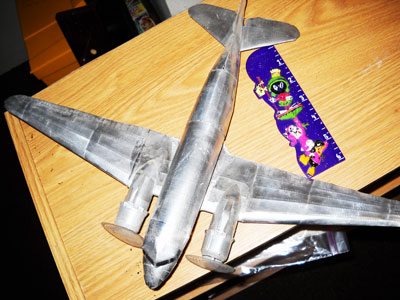 |
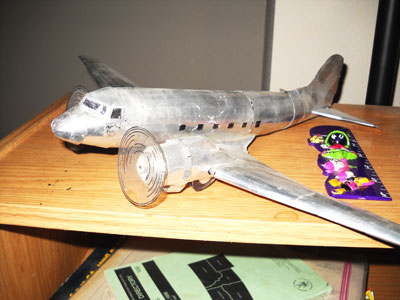 |
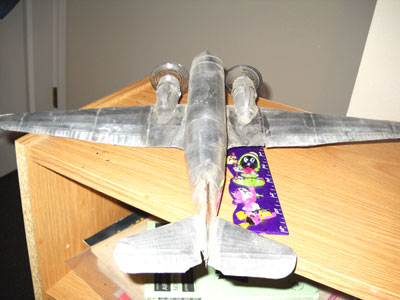 |
A few years back (That explains the dust!) I built this C-47 using the FG paper kit as a pattern. It is all pop cans (OK I also used 1 24oz beer can *burp*) except for the wing fillets. The curves there proved too complex, but aluminum foil worked well. If you look close under the pilot's window you can see her name in nose art; 'Pop Can Polly.' I also built a similar B-24 in the same scale, but after being surprised on father's day with a ride in the Colling's Foundation Liberator, I presented it to the crew. BTW, I'm a 100 hr private pilot, so after the flight I got the pilot to endorse my log book. I'm the only kid on the block that has .5 logged (as photographer/observer) in a B-24J. Keep up the good work Chip. Thanks for many hours of enjoyment and about 75 planes around the home. Tim |
Popcan Skytrain submitted by Tim Louden. In your card modeling you're saving trees and enjoying your favorite beverage. Thanks Tim!
Video Tour through a Douglas C-47 Skytrain!
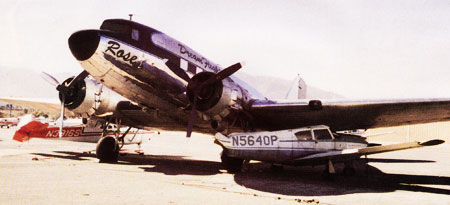 |
The DC-3 was pushed backwards by the wind into two other aircraft, destrying one and seriously damaging the other. |



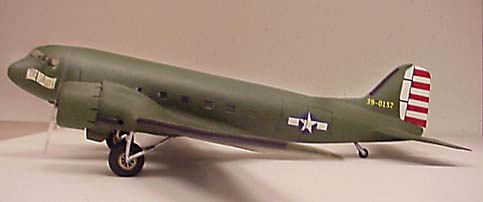
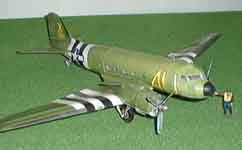 Model
sent by Wayne Cutrell. Thanks Wayne! All Wayne's photos
are of little dioramas with he model he's made.
Model
sent by Wayne Cutrell. Thanks Wayne! All Wayne's photos
are of little dioramas with he model he's made.